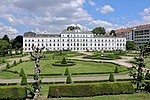Brigittenau

Brigittenau (German: [bʁiˌɡɪtəˈnaʊ] (listen)) is the 20th district of Vienna (German: 20. Bezirk, Brigittenau). It is located north of the central districts, north of Leopoldstadt on the same island area between the Danube and the Danube Canal. Brigittenau is a heavily populated urban area with many residential buildings.The district's name comes from the Brigitta Chapel, built between 1645 and 1651. It consists of a good tract of land secured by the regulation of the Danube 1870–75, and many of the major streets are named after members of the Danube Regulation Commission. Therefore, it does not contain any distinctive historical areas. Brigittenau was separated from the 2nd district in 1900. Earlier component districts were named Schottenau, Wolfsau, Taborau, and Zwischenbrücken. The best-known landmark is the Millennium Tower. The district also includes Adolf Hitler's former residence in Vienna, the Meldemannstraße dormitory.
Excerpt from the Wikipedia article Brigittenau (License: CC BY-SA 3.0, Authors, Images).Brigittenau
Stromstraße, Vienna Brigittenau (Brigittenau)
Geographical coordinates (GPS) Address Website Nearby Places Show on map
Geographical coordinates (GPS)
| Latitude | Longitude |
|---|---|
| N 48.236666666667 ° | E 16.369444444444 ° |
Address
Technologisches Gewerbemuseum
Stromstraße
1200 Vienna, Brigittenau (Brigittenau)
Austria
Open on Google Maps









